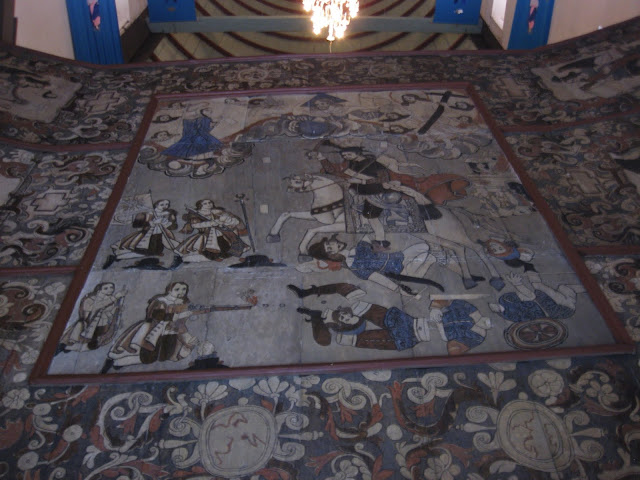We have all, of
necessity, been preoccupied with too many gloomy topics in the last several
weeks. I thought this might be a good time for something colourful and cheery. A
visit to Mexico is always a feast for the senses, so I thought an online
exhibition of some of the visual pleasures of Mexico would provide some needed joy.
A phrase that has
stuck firmly in my mind while reading for my Mexico project is a comment that
ancient Mexicans were “people of the book”. They kept records of all manner of
things, using a pictographic writing system on paper made from fig bark. Stone
tools for pounding bark into paper are frequently found in archaeological
sites. Nowadays, paintings on fig bark are a popular form of tourist art in
Taxco, a colonial silver mining town about 180km from Mexico City. Over the
years I bought a few paintings that appealed to me. The first two were made in
Maxela, a village about 100km south of Taxco, which specializes in bark
painting.
 |
| Paintings on amate (fig) bark from Maxela, Guerrero |
Like most tourist art,
these views are idealized, but they succeed in portraying various aspects of village
life. The architecture of the houses and church are reasonably accurate. The leisure
activities are typical of rural Mexico: the charreada (a variety of
rodeo), the cock fight, the musical band. The fauna and flora are also
representative, with the exception of the coconut palms, imaginatively
transplanted a long way from the coast to the mountain village.
These two were bought in
the 1980s. I am not sure whether ploughs drawn by animals are still much used,
but they were a common sight in the 1970s when I travelled around rural
Guerrero. Hunting is definitely an important rural activity.
 |
| Paintings on fig bark purchased in Taxco, 1980s |
When the Spaniards
conquered Mexico in the 16th century they were few in number and
relied on indigenous labour for pretty much everything, including painting and
architecture/construction. While we were in Mexico in 2018 we visited two magnificent
churches in small towns in Michoacán. The 17th-century church in
Nurio has a magnificent painted ceiling over the entrance.
 |
| Painted entrance ceiling of the church of St James the Apostle, Nurio, Michoacán |
 |
| St James the Apostle façade |
 |
| St James the Apostle altar and retablo (reredos) |
To one side of the
church is an elegant chapel (known as a huatapera in Michoacán).
The interior of the 16th-century
church of Saint Bartholomew in Cocucho is much more restrained in its decoration,
but the splendid paintings over the entrance more than compensate. Angels serenade
on contemporary musical instruments while St. James the Moor Slayer goes about
his business of dismembering infidel Moors. Unfortunately, 16th-century
Tarascan craftsmen had never seen a Moor, so they assumed they looked much like
a Spaniard.
 |
| Church of St Bartholomew, Cocucho, Michoacán, façade |
 |
| This space, with its cross, would have been used in the 16th century to preach to Indians too numerous to fit in the church |
 |
| Paintings on the ceiling over the entrance, church of St Bartholomew, Cocucho, Michoacán |
 |
| Interior, St Bartholomew, Cocucho |
 |
| Our Ocumicho diablito |
A visit to Ocumicho, a
short drive from Zamora, where we stayed in 2018, took us to another huatapera.
It lacked the paintings of Nurio and Cocucho, but we were visiting in May, the
month of the Virgin, so the church was a riot of flowers, topped up every day
by young girls. Ocumicho is a centre for crafts, particularly ceramics. The
local potters specialize in making diablitos (little devils), and a side-line
in erotic sculpture which earns the severe disapproval of the village priest. We
opted instead for a painting of the Virgin of Guadalupe, which would surely have pleased the priest. Our diablito and the Virgin are the work of Octavio
Esteban Reyes.
 |
| The huatapera of Ocumicho, Michoacán, altar and flowers in May 2018 |
 |
| The huatapera of Ocumicho, façade |
 |
| Octavio Esteban Reyes, Virgin of Guadalupe |
 |
| Octavio Esteban Reyes, Ocumicho, Michoacán, May 2018 |




















Thanks for the photographic tour. Back in 1966 Mike Coe and I were working in the basement of the newly-opened Museo Nacional de Antropologia in Mexico City studying the pottery from our excavations at San Lorenzo. People selling amate paintings would occasionally show up selling their own paintings. Oh, how I wish I had purchased a few.
ReplyDelete